The 2023/24 UEFA Champions League has concluded with European giants Real Madrid adding a 15th trophy to their already jam-packed cabinet, increasing the gap between themselves and second-placed AC Milan to eight titles.
At the same time, Carlo Ancelotti has become the first manager to lead a team to the summit of European football on five separate occasions — a fitting achievement for the 64-year-old expert in elite leadership and high performance at the very top level.
On the losing side were Borussia Dortmund, who last finished as runners-up in the UEFA Champions League 11 years ago. Fans of BVB had the privilege of seeing their players lift the illustrious trophy just once—the 1996/97 campaign.
This triumph occurred under the tutelage of Ottmar Hitzfeld, who would go on to lead a team to European glory once more in 2000/01, then with BVB’s Der Klassiker rivals, FC Bayern.
On paper, it was Real Madrid’s final to lose.
The stage had been set for Europe’s most successful team and coach to see off the challenge of perennial underdogs on the grandest stage BVB under 41-year-old relative newcomer to elite management, Edin Terzić.
However, the game itself played out in a far different manner, with a key half-time tactical switch from Los Blancos and their experienced mastermind proving vital to a momentum shift that would ultimately see Real Madrid over the line by the end of 90 minutes, having been on the back foot for much of the first 45.
This Real Madrid tactical analysis breaks down how this game played out in the first half, why Borussia Dortmund entered the midway break with momentum on their side, and how Real Madrid formation turned things around in the second half to ultimately come away victorious.
Lineups
Before moving on to providing an analysis of the tactics of both sides from the 2023/24 UEFA Champions League Final, we’re going to quickly run through the formations and lineups from both teams.
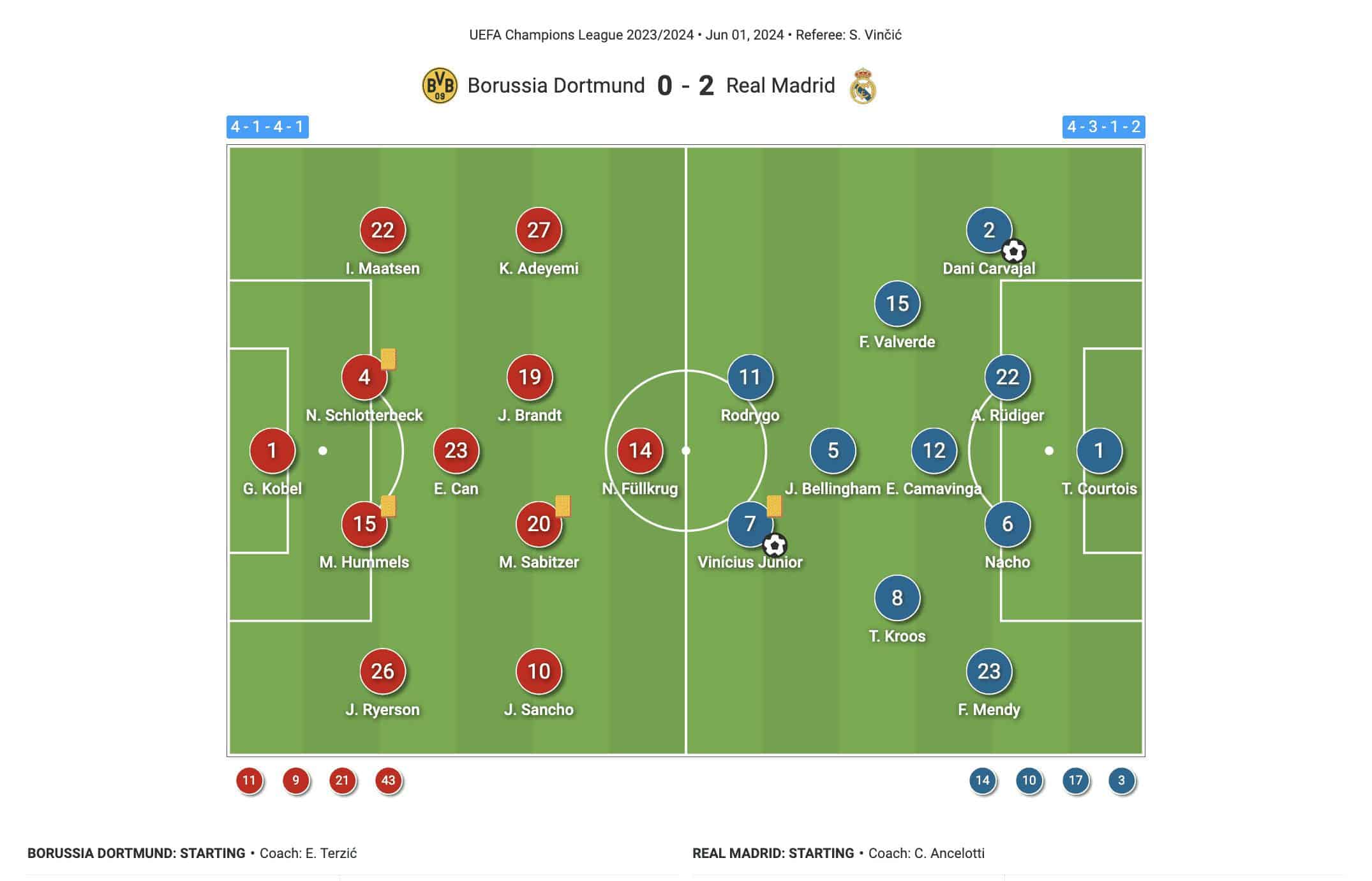
Dortmund primarily lined up in a 4-1-4-1, as depicted above, during Saturday’s game, with Gregor Kobel in goal behind a back four consisting of Julian Ryerson at right back, Mats Hummels at right centre-back, Nico Schlotterbeck at left centre-back, and Ian Maatsen at left-back.
Emre Can captained BVB and started in the holding midfield position with Julian Brandt just to his left and Marcel Sabitzer just to his right in central midfield.
Niclas Füllkrug started up front for the German side, with Karim Adeyemi and Jadon Sancho on the left wing and right wing, respectively, on either side of him.
Dortmund made four substitutions over the 90-minute match, the first of which saw Adeyemi make way for BVB legend Marco Reus in the 72nd minute.
Donyell Malen and Sébastien Haller came on in place of Emre Can and Julian Brandt with 80 minutes on the clock for Dortmund’s second and third substitutions before Jamie Bynoe-Gittens replaced Jadon Sancho after 87 minutes, making the 19-year-old attacker the Bundesliga giants’ final incoming substitute of the contest.
As for Los Blancos, Carlo Ancelotti set his team up in something resembling a 4-3-1-2 in possession, but Real Madrid typically appeared in more of a typical 4-4-2 with Jude Bellingham moving from the ‘10’ position he occupies in figure 1 to a left-wing position during out-of-possession phases.
Thibaut Courtois started between the sticks for the Spaniards behind a back-four featuring scorer of goal number one in Saturday’s Final Dani Carvajal at right-back alongside Antonio Rüdiger at right centre-back, Nacho at left centre-back and Ferland Mendy at left-back.
Eduardo Camavinga was Real’s most central midfielder, with Toni Kroos normally found deeper and to the left while Federico Valverde played a box-to-box role on the right.
Jude Bellingham, as mentioned, played a hybrid ‘10’/left-winger role depending on if his side were in or out of possession, with Vinícius Júnior ahead to his left and Rodrygo to the right of the attack.
The new European champions also made four substitutions over the course of the game, though they held off until quite late to make any changes at all.
Firstly, Bellingham and Kroos were taken off for Joselu and Luka Modrić in the 85th minute. Soon after, just as the game approached the 90th minute, defender Éder Militão came on for attacker Rodrygo.
As the game wound down to its final moments, Real made their final sub with Lucas Vázquez making a cameo appearance for Real’s second goalscorer of the contest, Vinícius Júnior, whose fans enjoyed the opportunity to send their appreciation as he departed in the fifth minute of stoppage time.
First half: Real Madrid in possession vs Dortmund out of possession
With lineups and general formations clarified, let’s start off by analysing Real Madrid’s performance in possession during the first 45 minutes of Saturday evening’s showdown.
Real absolutely dominated possession in the first half, taking a patient, methodical approach to building their attacks from the back and, crucially, pressing very high up the pitch during the initial 45 minutes of the game, aiming to deny their opponents the same time on the ball.
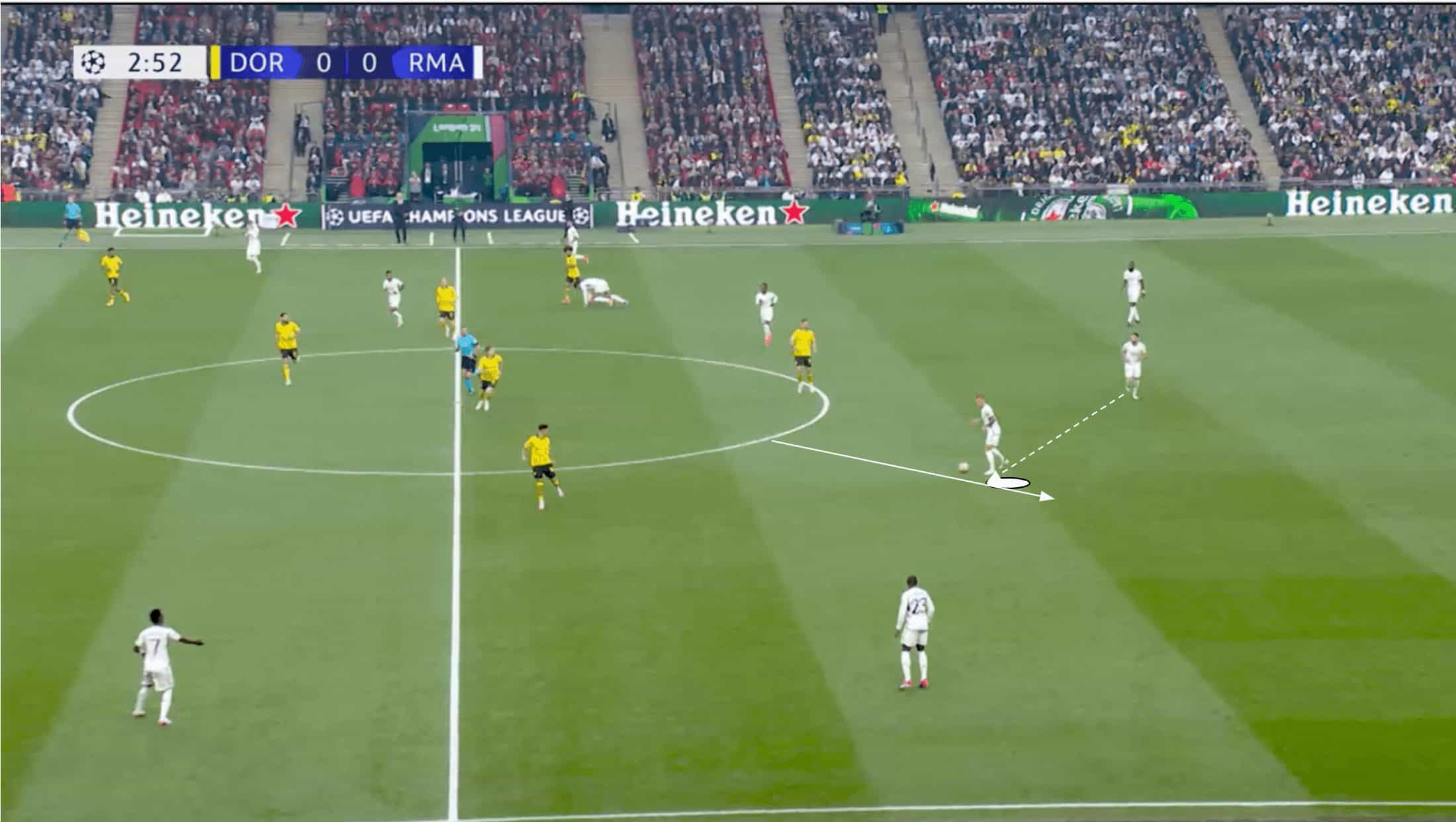
Left central midfielder Kroos was pivotal to his side’s possession game in the first half, with pretty much everything running through him in terms of build-up and ball progression. He frequently dropped deep and to the left, essentially occupying the position of a left centre-back in possession for much of the game, as shown above.
The aim, essentially, was to force the opposition midfielders to press higher to combat him and his deep positioning, which we often saw Sabitzer do. This would open up space in midfield for another Madrid player, such as Bellingham, to exploit either in Sabitzer’s vacated right central midfield pocket or—should Emre Can push up into that space—in between Dortmund’s midfield and defensive lines.
Kroos was often found playing passes into the space opening up as a result of Dortmund’s midfield pressing him throughout the game, and it was clearly a key tactical instruction for Madrid to look for that space and exploit it where possible.
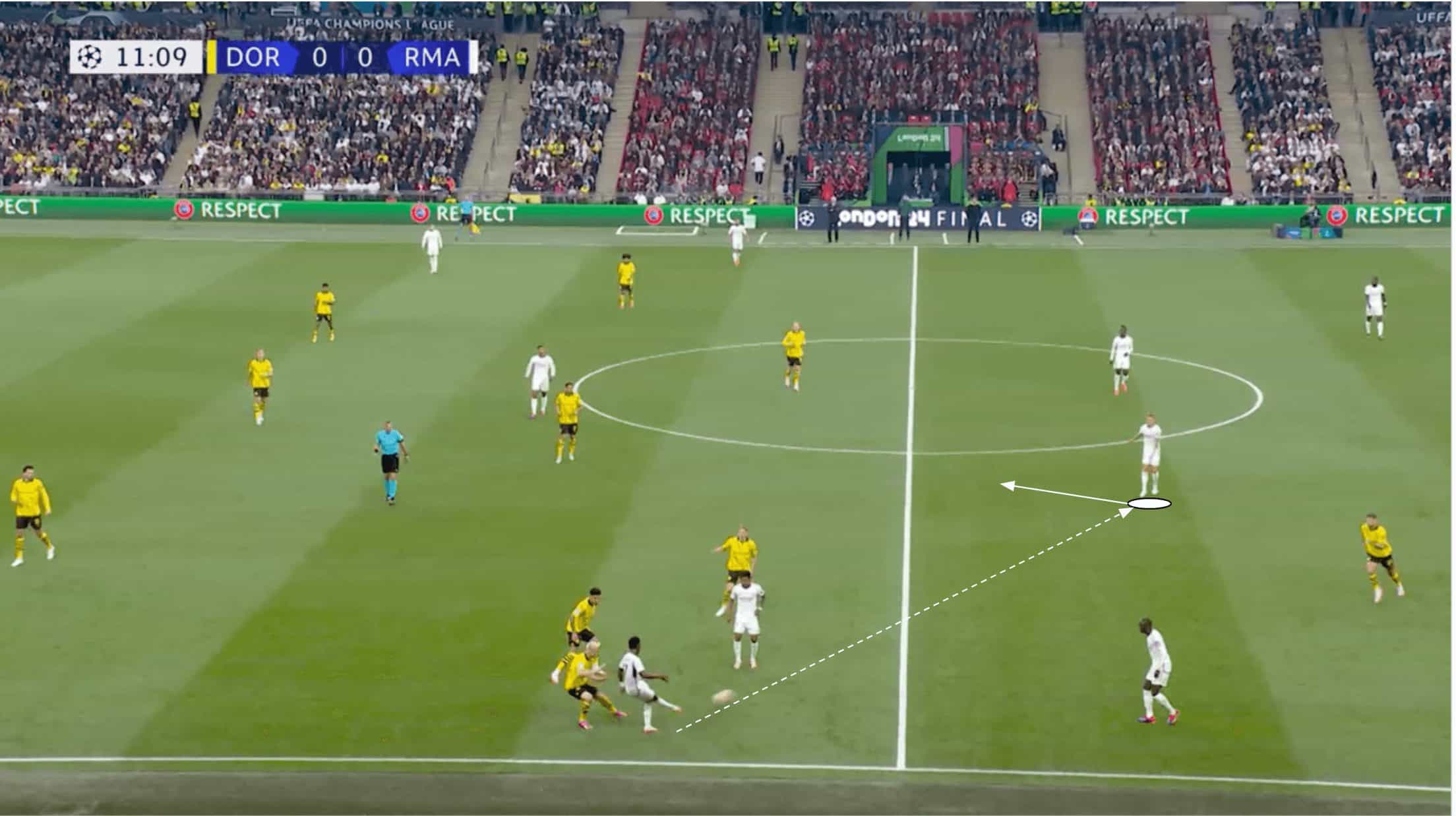
At times, Madrid found Kroos in space with no markers around, such as in figure 3, when Madrid dragged Dortmund’s midfield to the left wing via some intelligent possession play, thus opening an opportunity for Kroos himself to advance into some vacated space in the midfield.
After receiving here, he turned out, got his head up and switched play to the right, setting up his right-winger and right-back in a 2v1 overload against Dortmund’s left-back.
The ease with which he quickly put his team in a highly advantageous offensive position highlights why it was essential for Dortmund to close him down throughout the game, denying him time and space even if it meant space would open up elsewhere in midfield; Kroos is capable of hurting you either way via his masterful passing.
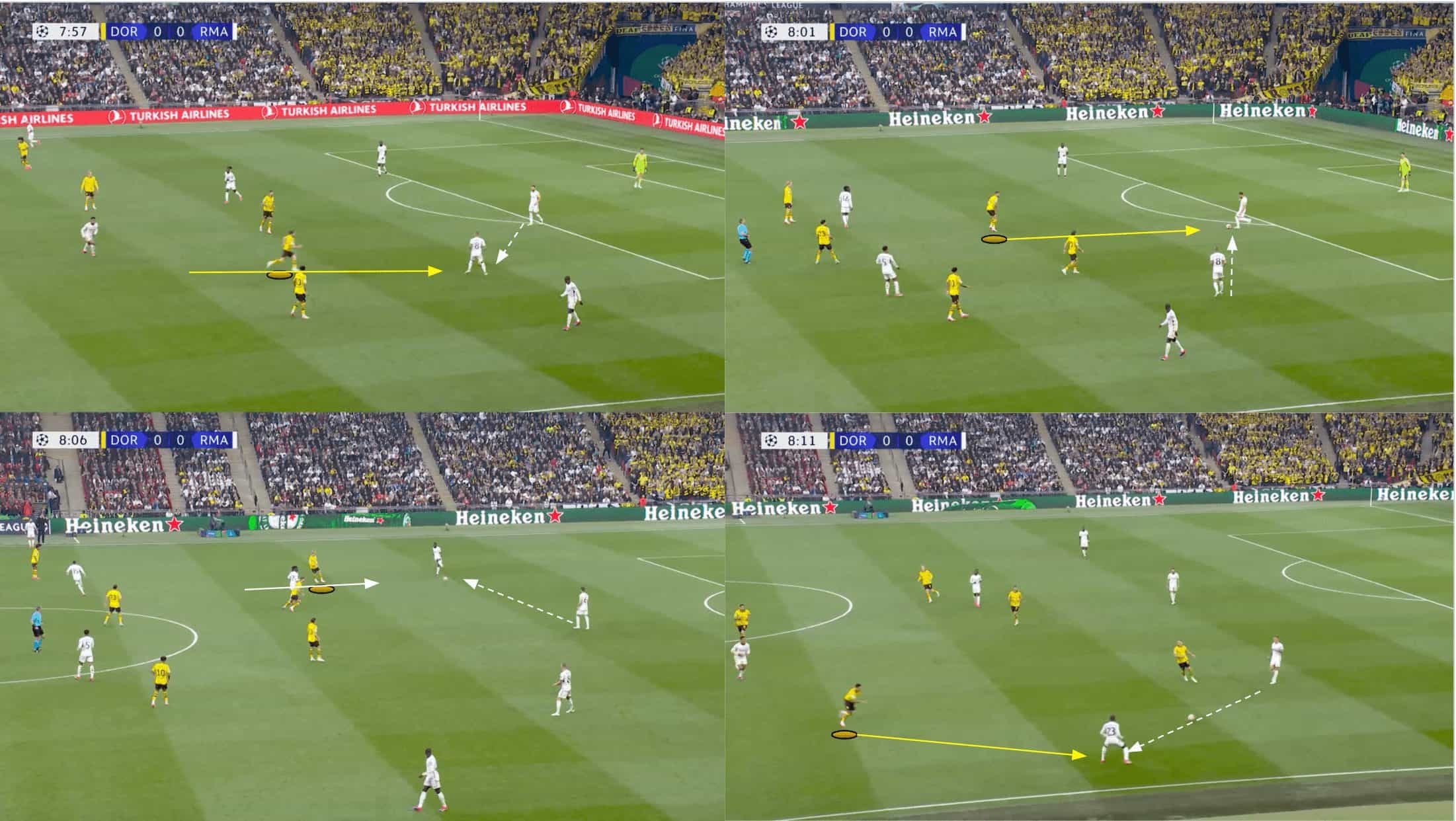
Dortmund pressed high and closed down Real Madrid’s ‘back-five’ (including Kroos) as they tried to build attacks from the back. They didn’t make it easy for Los Blancos to create a deep overload and create a free man — especially Kroos — through whom they could then progress into dangerous positions. The German side was quick, aggressive and committed to pressing while keeping passing options in their respective cover shadows, and this even resulted in a few high turnovers, with Madrid getting caught in possession on occasion.
Overall, Madrid’s possession play was patient. Still, they struggled to be very incisive against Dortmund, with Terzić setting his side up in a very solid defensive structure. At the same time, the players executed their pressing instructions to a tee, leading to a lot of sideways passing from Los Blancos in the backline.
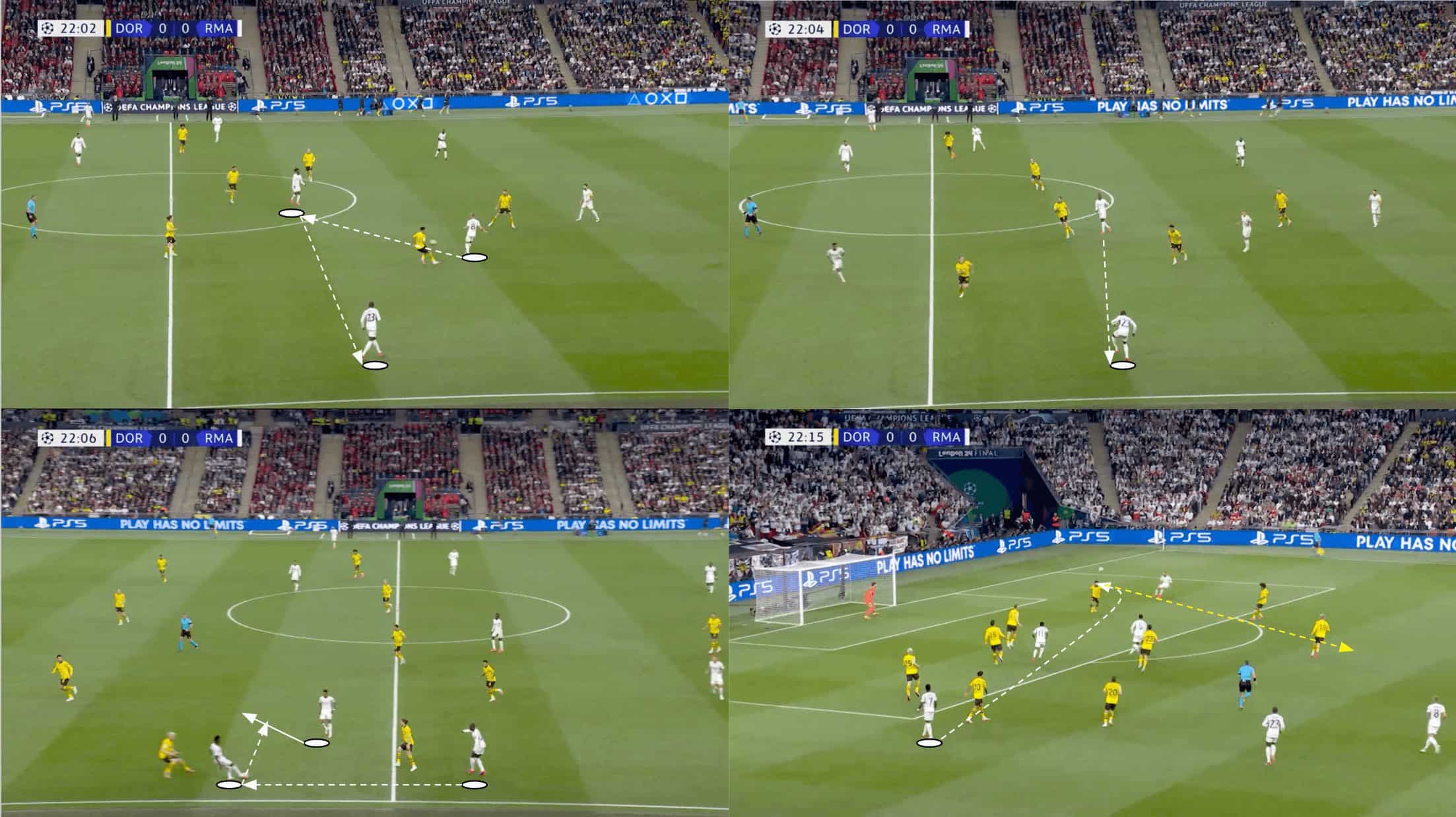
There were plenty of occasions when Real did manage to play through Dortmund in the middle third and progress to the final third, one example of which we see in figure 5. The attacking duo of Vinícius Júnior and Rodrygo proved vital to Real’s ball progression, with the wings ending up a key area where Los Blancos caused BVB plenty of problems.
However, as we see above, the final third was often as far as Real progressed, with many attacks ending. A fruitless ball into the box was easily dealt with by BVB, who could now set off on the counter.
Real lacked a presence in the box throughout this game, with Rodrygo and Bellingham often too late to arrive to Vinícius Júnior’s crosses, failing to really trouble the imposing centre-back duo of Hummels and Schlotterbeck.
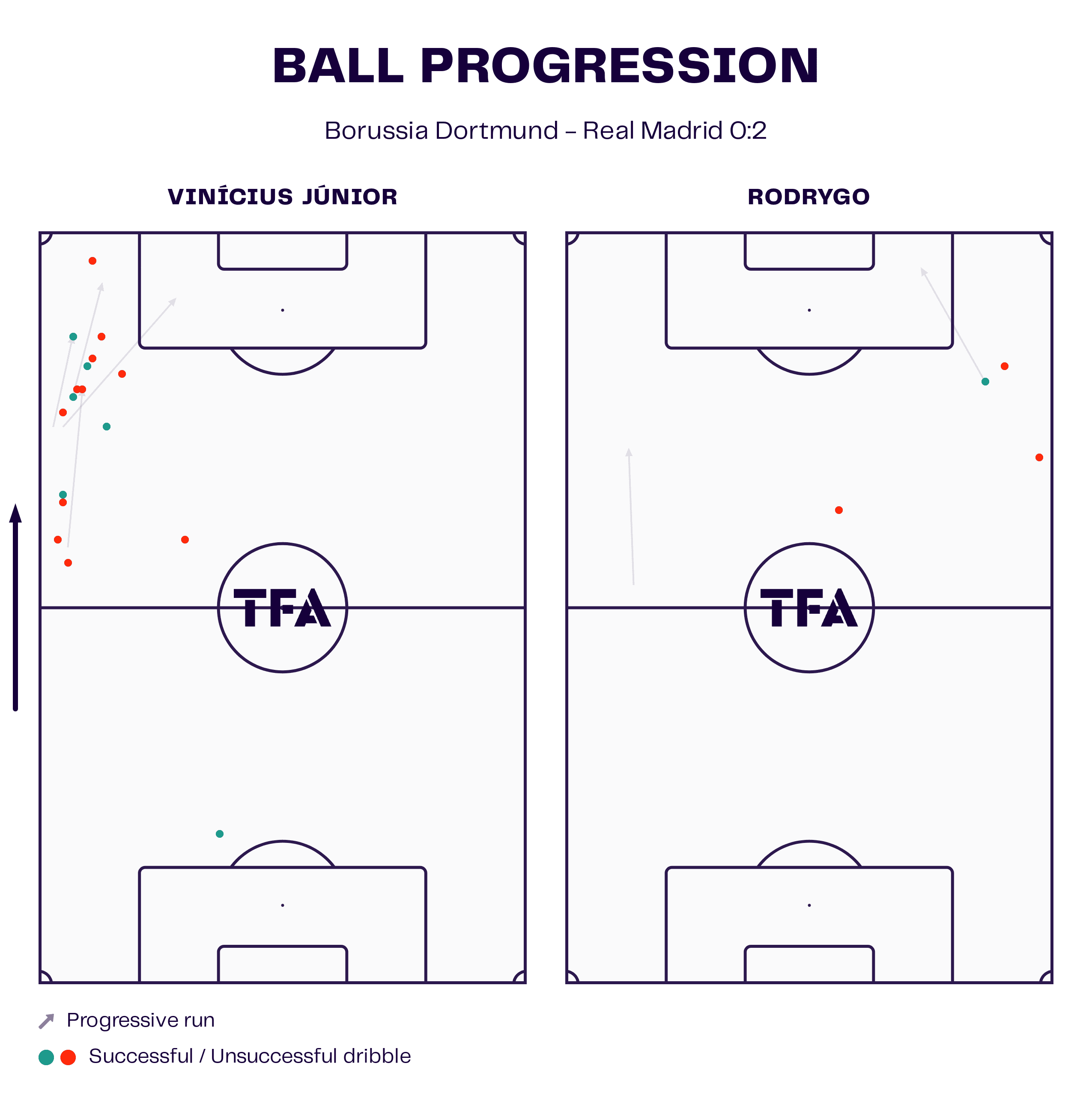
Not all of Vinícius and Rodrygo’s dribbles came off for Real on Saturday. In fact, just six of Vinícius’ 17 dribbles were successful, while one of Rodrygo’s four were. There were some very good 1v1 battles out on the wings, and momentum primarily favoured BVB’s defenders on this occasion. However, the wide men — and Vinícius in particular, with a whopping 17 dribble attempts — were a vital outlet for Real’s ball progression. Los Blancos relied on these two as players they could send the ball to and retain it, bravely taking on the BVB defence repeatedly, generating some box entries as a result.
Still, Real ended up creating just 0.03 xG in the first half — a highly disappointing number — as they really struggled to actually connect with the balls played into the box, thus BVB’s goal remained largely unthreatened in the first 45.
First half: Dortmund in possession vs Real Madrid out of possession
On the flip side, Dortmund spent the vast majority of the first 45 minutes without the ball but ended up generating 0.78 xG in the first half.
The xG difference of 0.75 in favour of Dortmund emphasises just how toothless Real were with their possession in the first half and how much of a better first 45 minutes BVB had compared to the eventual winners. It’s clear that the Germans entered half-time as the happier of the two teams, so how did they manage it, given their lack of possession?
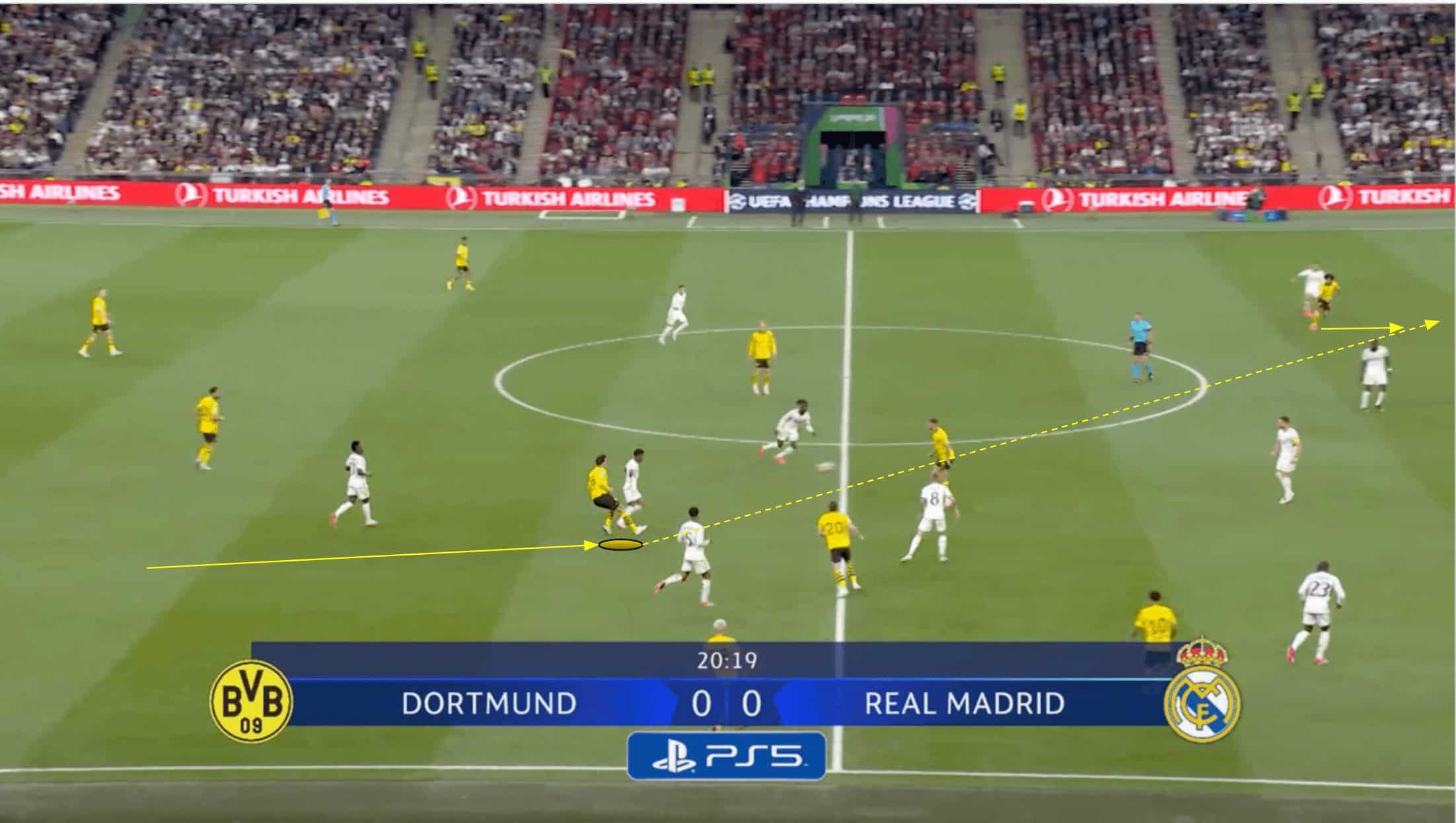
Essentially, the key was that Real Madrid pressed very high in the first half, meaning they played with a high backline. Dortmund’s expert ball-playing centre-back duo of Hummels and Schlotterbeck were well placed to act as key playmakers for their side as a result, with both men playing the ball in behind for their attackers to chase at times, as we see Hummels doing for left-winger Adeyemi in figure 7 above.
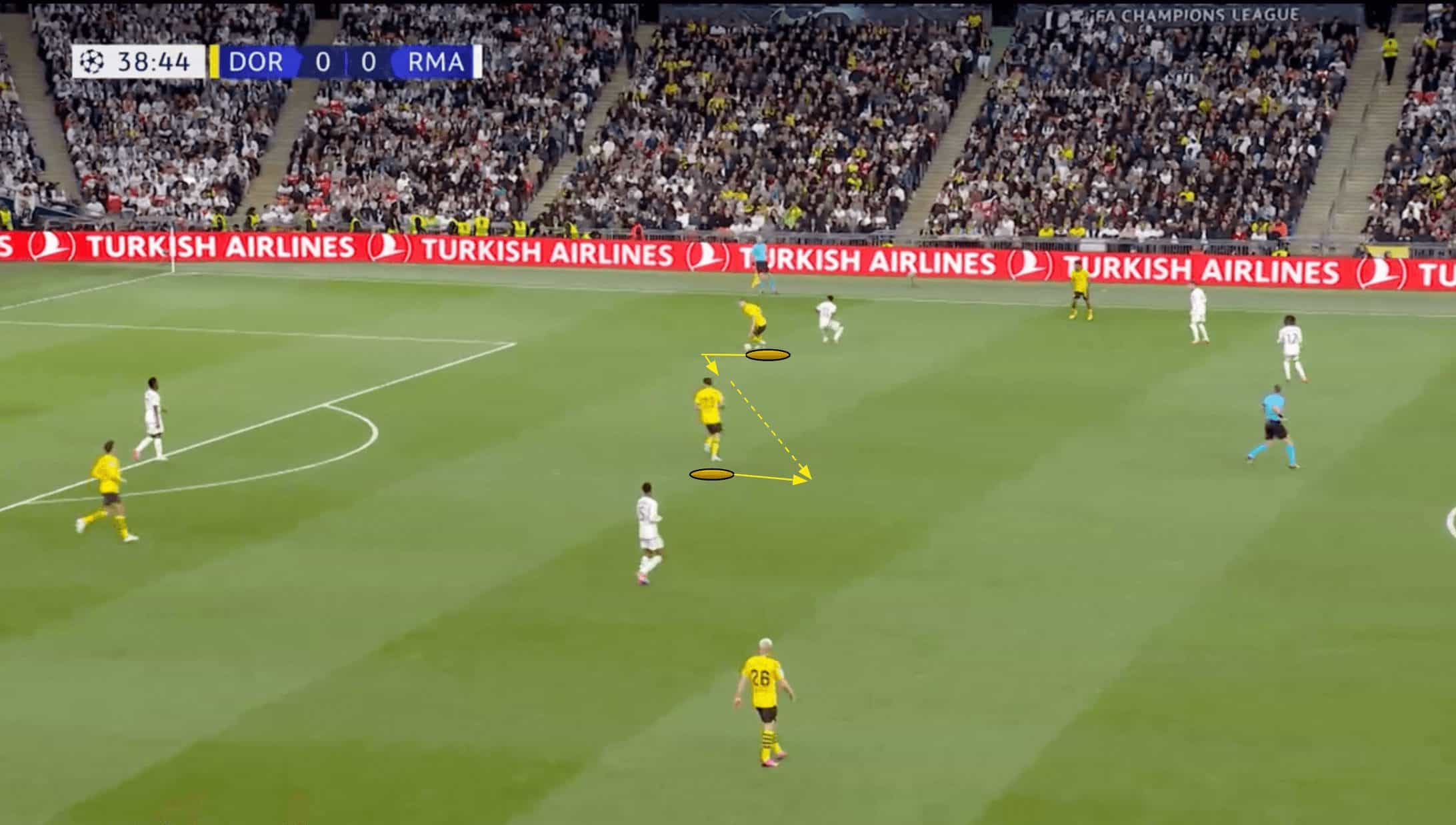
It wasn’t just Schlotterbeck and Hummels who acted as creators with balls in behind for BVB in this regard; everything flowed through them, and BVB committed to building out from the back via the two centre-backs.
Can, for instance, also played a vital role in this way. Still, Real’s forward duo of Rodrygo and Vinícius generally tried to keep the holding midfielder in their cover shadow while pressing the centre-backs.
However, Dortmund essentially got more and more joy in the build-up the more the first half went on, with their ability to manipulate the Madrid press growing as the Real forwards likely tired.
We see one example of this in figure 8, with Schlotterbeck having just received the ball from the goalkeeper; he baited Rodrygo’s press before turning his body while protecting the ball, opening up a passage through to Can in midfield. From there, Can had time and space in a highly valuable and useful position for ball progression, and he could use that time and space to get his team moving forward.
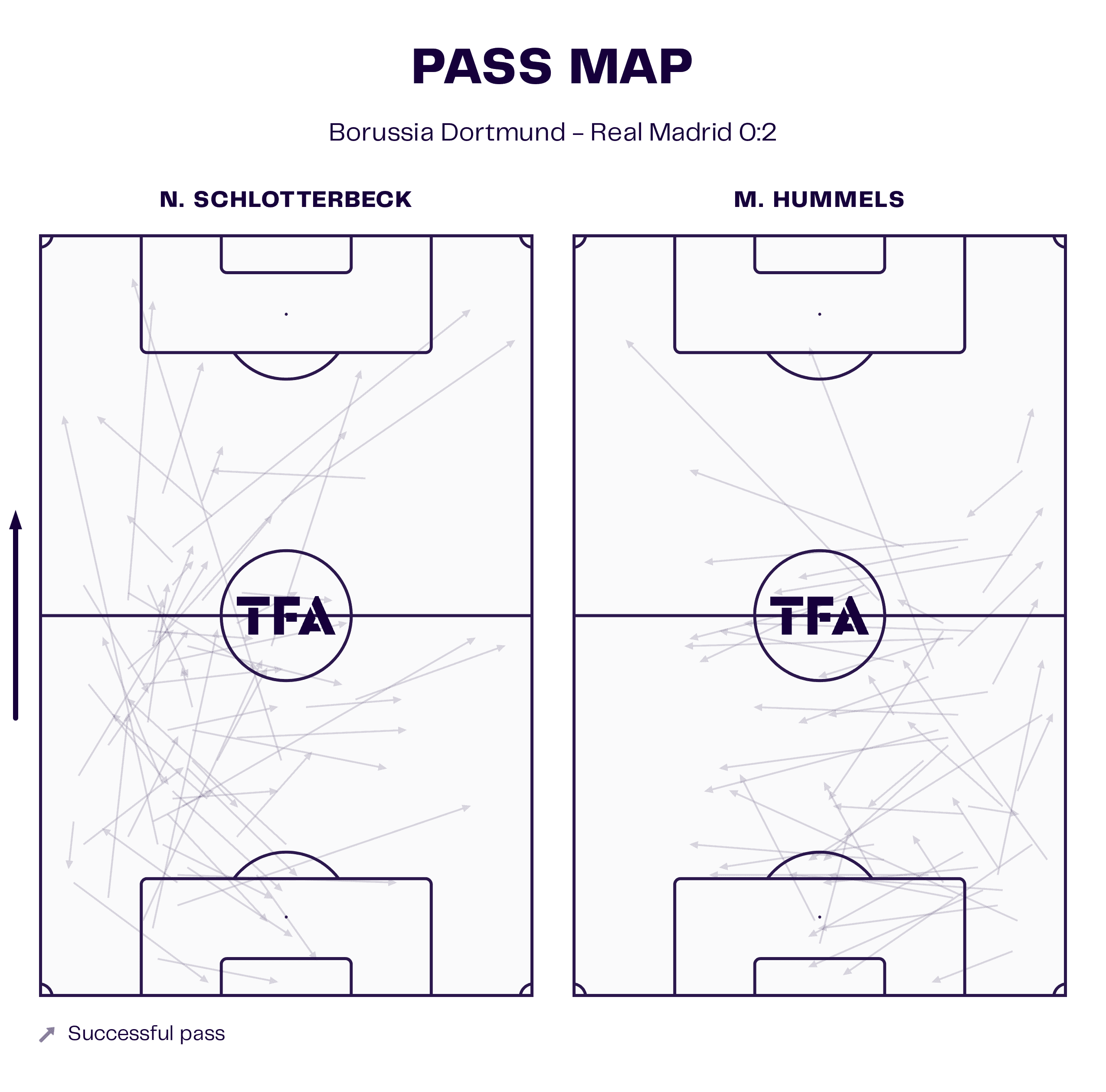
Schlotterbeck and Hummels both played plenty of long passes, including switches of play, to release teammates in behind the Real backline, and they also both got the ball into the midfield when space appeared, allowing those positioned in even more valuable playmaking positions to use that time and space to great effect against Los Blancos’ high backline — both in settled possession phases and transitional phases, with BVB thriving in both of those areas during the first 45.
BVB effectively exploited Real’s high line, which was the main reason for their dominance of chance creation in the first half. Along with the energy and organisation they brought to the pitch with pressing and, indeed, counterpressing, this also proved a key playmaker for the German underdogs.
However, in the second half, things took a big turn in favour of Real Madrid.
Second half: Real Madrid change the game by defending deeper
While in the first half, Dortmund ended up generating 0.75 more xG than Real, who created barely anything, the second half saw Real create 1.39 xG to BVB’s 0.09 — a significant turnaround in chance creation dominance, which ultimately summarises how the game took a complete 180 in the second half in favour of the new European champions; how did this happen? Fairly simply, with Real deciding to defend deeper, a decision which would ultimately change the dynamics of the game entirely.
Dortmund’s main source of chances in the first half was their effective exploitation of Real’s high backline, and Los Blancos took that avenue for chance creation away in the second half when they decided to drop a bit deeper, giving up less space behind the backline.
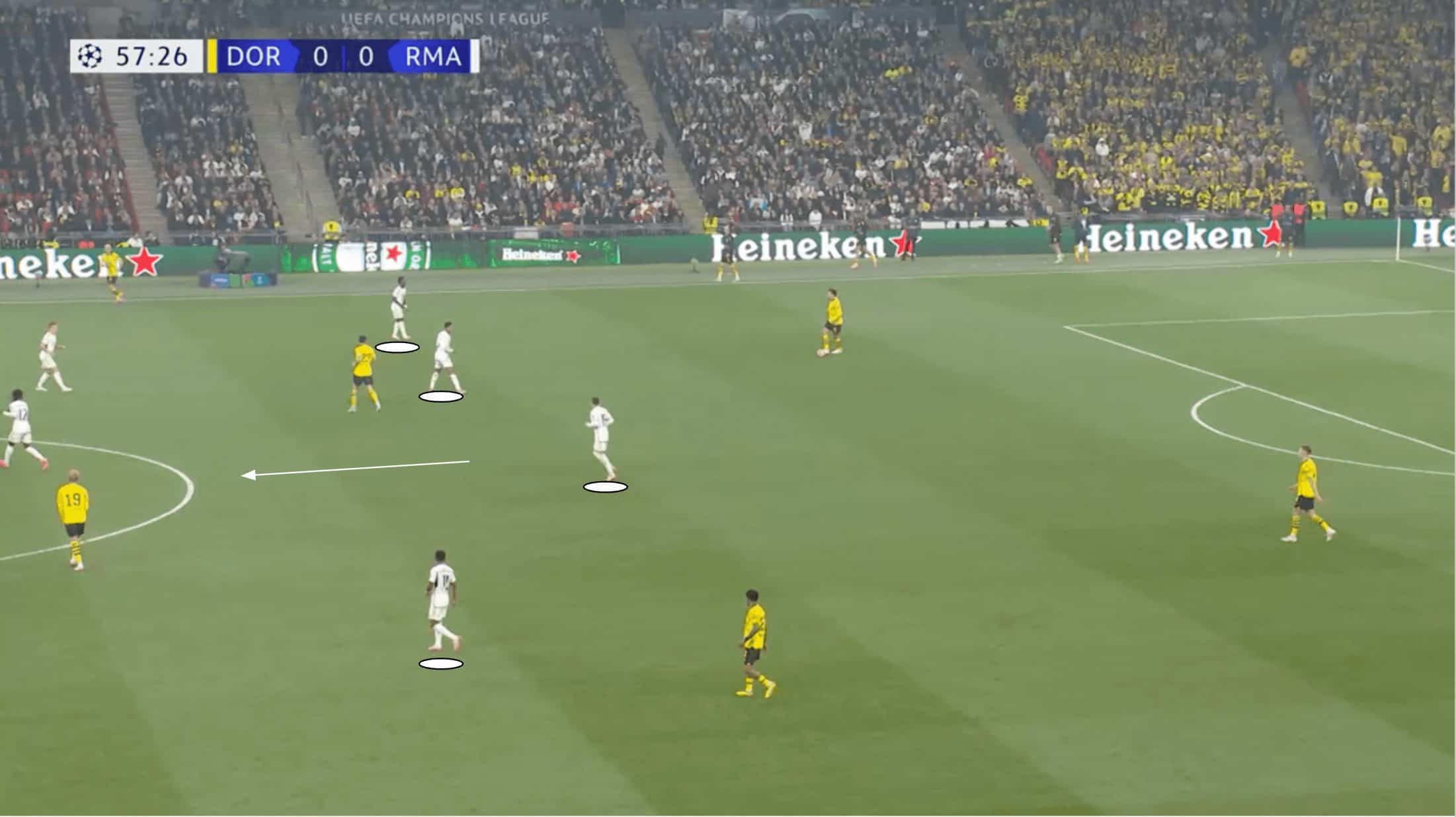
As figure 10 indicates, Real’s forwards didn’t press as high, meaning Dortmund’s centre-backs had more time and space on the ball. However, with Real’s backline also then dropping deeper, there was far less space for the centre-backs to aim for with balls in behind.
There was far less space opening up between the lines, with Can being marked far more tightly here than he was in figure 8, so the centre-backs’ options were significantly reduced. Their playmaking jobs became far more difficult, with Real posing these new questions to them in the second half.
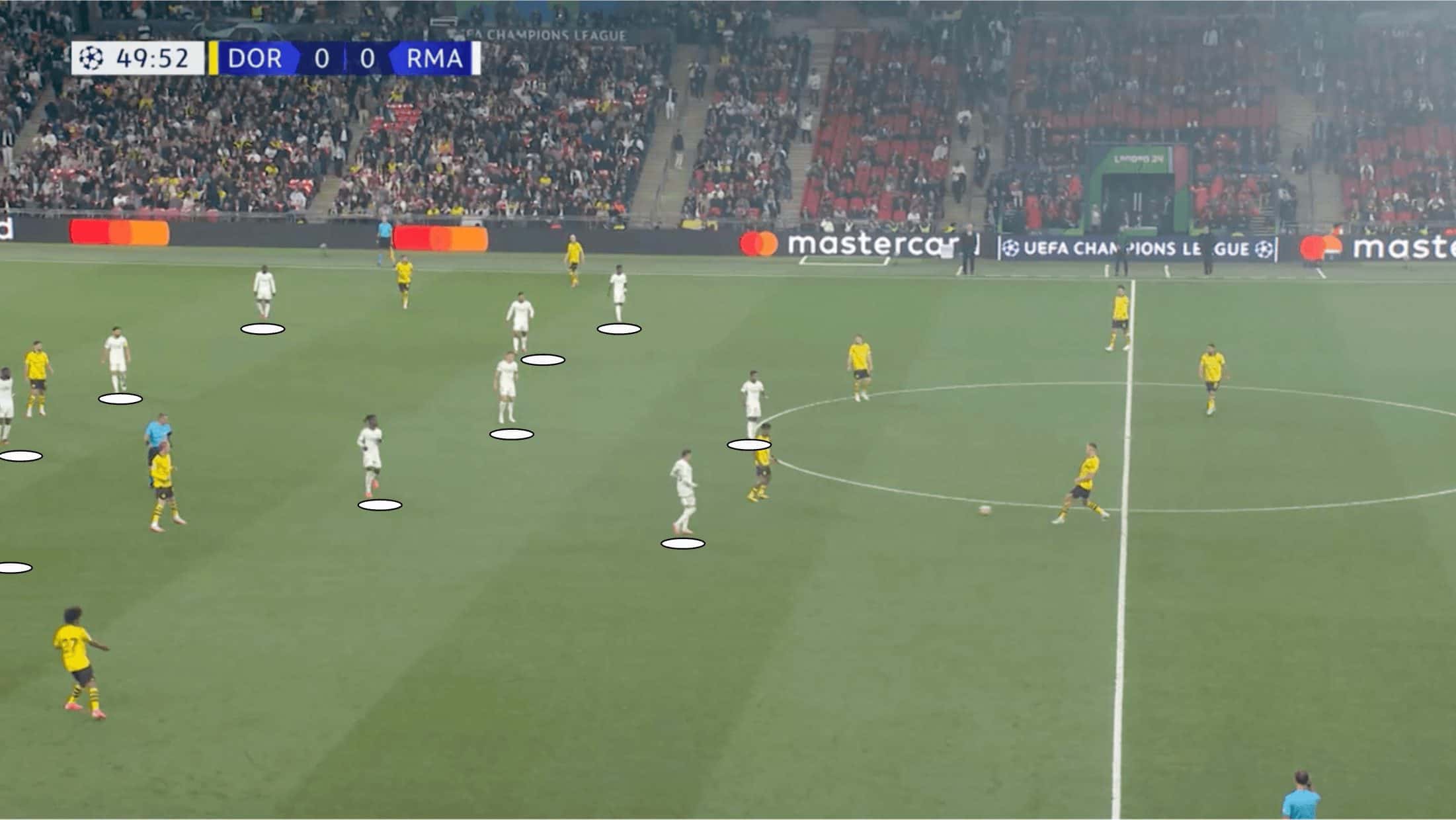
Real’s line of engagement dropped significantly, with the forwards not really pressing in the second half until the ball entered their half of the pitch. Space was now at a premium in central areas, and Real’s centre-backs found themselves defending space in front of them rather than space behind them much more frequently — a job they performed far better than the alternative which they usually found themselves tasked with in the first half.
BVB had a constant centre-forward presence in Füllkrug, who did his job very well, but Real’s centre-backs also managed to deal with fairly well in physical and aerial duels. Meanwhile, BVB’s wingers had far less space available to them, now having to beat Real’s full-backs 1v1 versus attacking space behind them.
This gave Real less of the ball, but they had largely failed to make much of an impact with their possession in the first half anyway, while they gave BVB more of the ball but denied them the more favourable opportunities for chance creation they’d enjoyed in the first half.
As Dortmund’s attacks now began to fizzle out to nothing and they found themselves making it to Real’s box less and less compared to the first half, confidence and momentum shifted in favour of Real, who grew into the game and found themselves at least testing Dortmund’s defence and goalkeeper more and more as the second half grew on.
Their chances, largely, were not clear cut but they did manage to force some fouls to create free kicks and force some saves and blocks that led to corner kicks, which Los Blancos could use to sustain pressure.
With a lack of a real centre-forward presence persisting, some of Real’s best chances in the second half came from set-pieces, including their first goal.
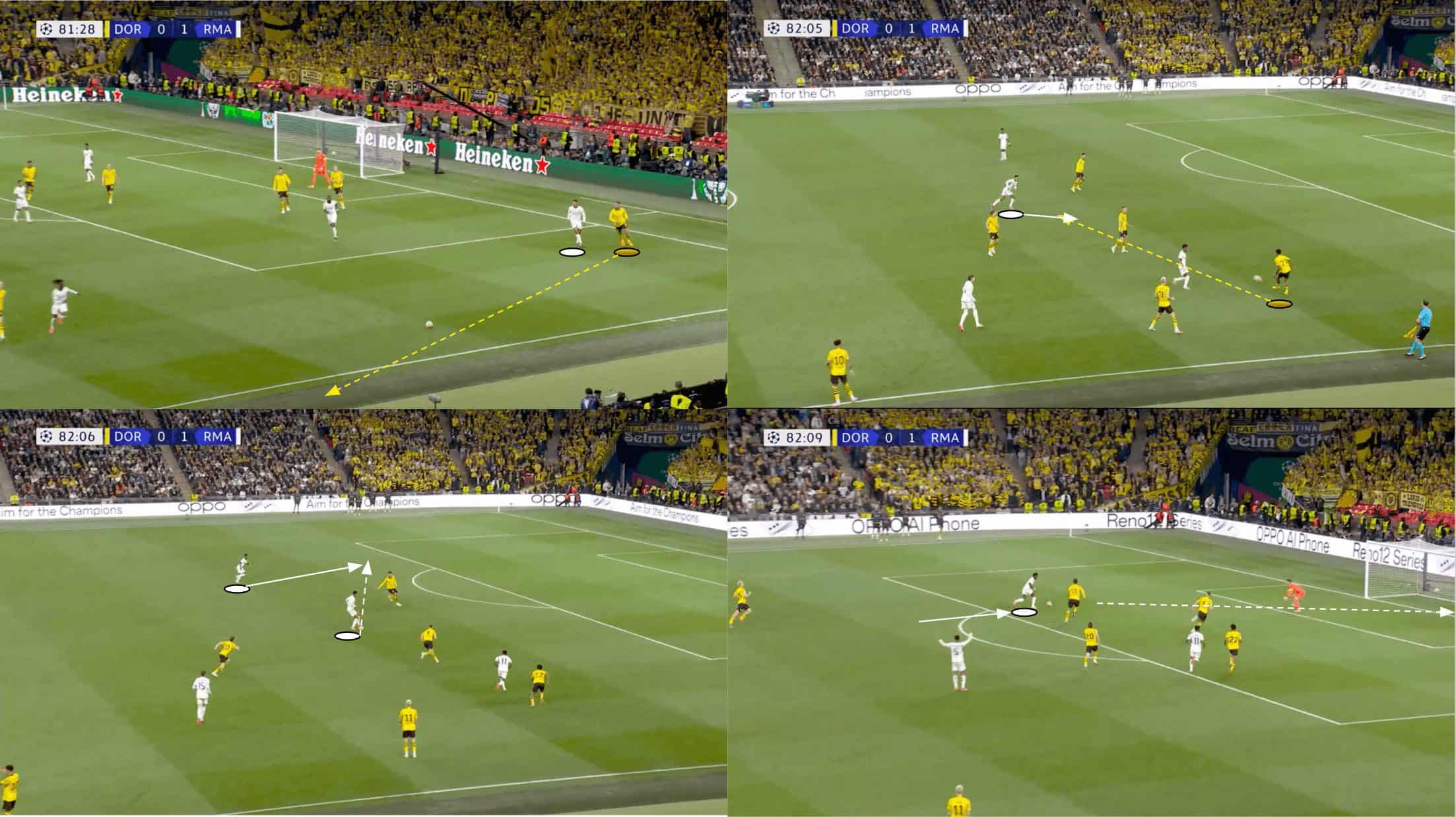
With BVB now losing and failing to threaten Real like they did in the first half, while Real kept sustaining pressure and pinning them in their half, BVB became restless and rushed, at times, in their play. We see this as, just after a corner kick, Bellingham pressed Haller into just driving the ball out of play on the edge of Dortmund’s third, giving Real a throw-in in a fairly dangerous position.
Dortmund managed to regain possession shortly after the throw-in, but the slightest bit of pressure on Maatsen this time forced another error from the stressed Dortmund left-back, who was rushing his play and not taking enough care before passing.
His ball across goal was intercepted by Bellingham, who was able to set up Vinícius Júnior for one of the only decent chances Real generated from open play in this whole game — but it was enough to put the Champions League Final beyond all doubt.
Momentum is an intangible quality in football, but we have some clear examples here of how Carlo Ancelotti and his side halted Dortmund’s momentum from the first half as they entered the second. They knocked their confidence by defending differently and shutting off their primary source of chances before continuing to grow into the game themselves with the continued creation of set-piece opportunities, one of which they capitalised on.
From there, they just had to keep control of the centre as they had been doing throughout the second half and allow Dortmund to effectively lose their heads more and more as they became desperate. This gave the calmer and cooler Real — a reflection of their coach who’s been there, done that and seen it all in the UEFA Champions League — one more key chance to finish the game.
Conclusion
All in all, Real Madrid tactics were a delight to watch.
Real’s call to drop off a bit in the second half was a masterstroke, and one small call completely altered the dynamics of this game, creating a second half entirely different from the first.
This shifted things far enough in favour of Los Blancos to deliver a 15th Champions League to the Santiago Bernabéu, making their dreadful first half a distant, insignificant memory.





Comments